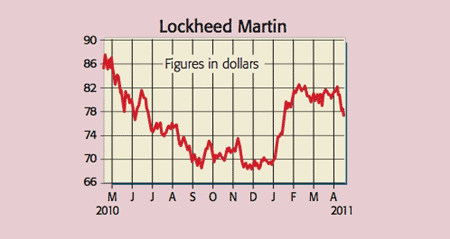
President Obama was banging the table last Thursday – this time about his plans to lop the public-sector deficit from today’s gigantic 10.9% of GDP to 2.5% by 2015. One idea is to shave a few more per cent off the Pentagon’s base budget of $550bn. No wonder shares in Lockheed Martin, the world’s largest defence contractor, fell. But this looks like a knee-jerk reaction.
Weapons programmes have historically proven harder to kill than cockroaches, partly because of the skilled jobs they create. Also, Lockheed’s four divisions – electronic warfare (31% of 2010 sales), aeronautics (29%), information (22%) and space systems (18%) – are state-of-the-art, supplying a host of warplanes, ships and cyber-terrorism kit to the US (85%) and overseas military units.
But the key to its future is the F-35 Joint Strike Fighter – the biggest weapons contract ever. Lockheed has been asked to build 3,000 super-agile jets for the American and allied forces at a total cost of $323bn. It will bag more than twice that sum from spin-off maintenance and spares work.
Doesn’t this immense scale make the F-35 a target for Obama’s deep cuts? Yes and no. There is likely to be some tinkering at the edges. But thanks to the previous cost-saving plan, the plane is now the only show in town. It is designed to replace much of America’s aerial strike fleet and will also form the spine of allied air forces around the world. Because the Pentagon has chosen to procure only one basic model to serve all applications, it has put all it combat-jet eggs into one basket. So if Uncle Sam cancelled the aircraft, it would delay the military’s access to a next-generation fighter by more than a decade.
Lockheed Martin (NYSE:LMT), rated a BUY by Sanford Bernstein
All of this suggests that the bulk of the F-35 programme is close to untouchable. Even if deliveries were chopped in half, it would still be worth 7.5 years of production for Lockheed at peak rates.Better still, once the plane begins large-scale production, profit margins should accelerate from low single digits now to 10% and upwards by the middle of the decade. True, there’s a danger of downsizing as troops are withdrawn from Iraq and Afghanistan. But because Lockheed specialises in expensive items produced under decades-long contracts, any impact from this should be manageable. What’s more, the world is certainly not getting any less dangerous, as evidenced by the situation in Libya.
The stock is cheap too, trading on a forward p/e ratio of less than ten while paying a 3% yield. The outlook for 2011 also seems positive – the $78.2bn order book gives revenue cover of around 74%. I would rate the stock on an 11 times underlying earnings before interest, tax and amortisation (EBITA) multiple. After adjusting for $2.2bn of net debt and $15bn in retirement liabilities, that generates an intrinsic worth of about $90 per share.
What are the possible headwinds? Dealing with governments brings its usual headaches. And for British investors there are also foreign-exchange considerations. Nonetheless, despite fears of budget cutbacks, the group looks well placed to achieve consistent earnings momentum over the economic cycle. Sanford has a price target of $101 per share. First-quarter 2011 results are out on 26 April.
Recommendation: BUY at $78